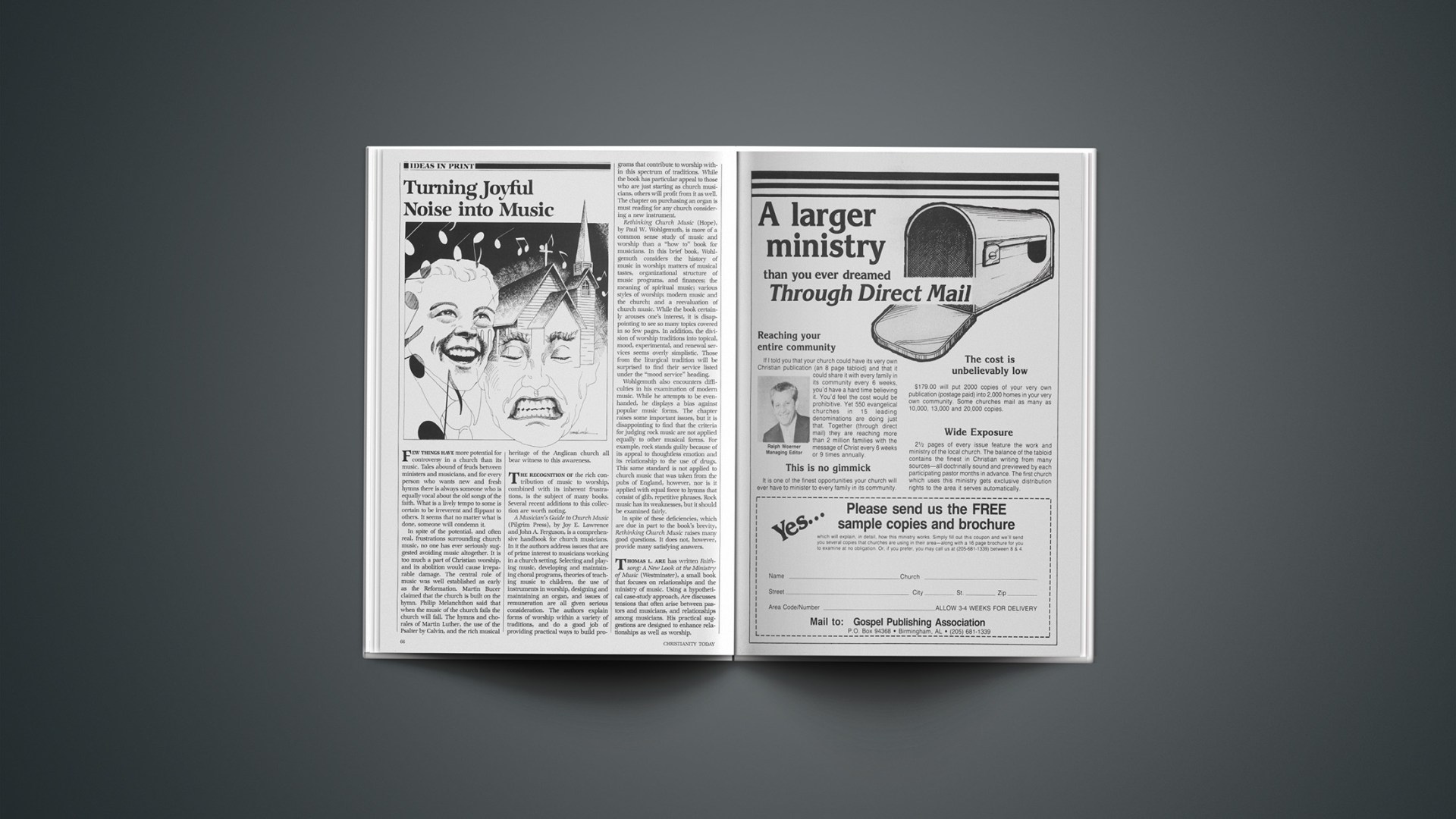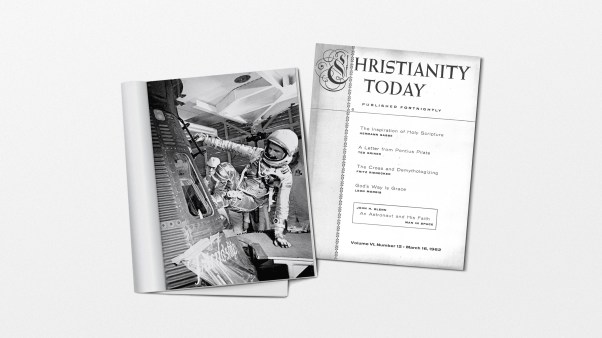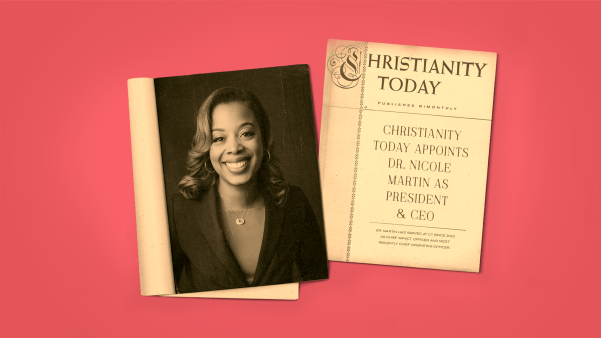Turning Joyful Noise Into Music
Few things have more potential for controversy in a church than its music. Tales abound of feuds between ministers and musicians, and for every person who wants new and fresh hymns there is always someone who is equally vocal about the old songs of the faith. What is a lively tempo to some is certain to be irreverent and flippant to others. It seems that no matter what is done, someone will condemn it.
In spite of the potential, and often real, frustrations surrounding church music, no one has ever seriously suggested avoiding music altogether. It is too much a part of Christian worship, and its abolition would cause irreparable damage. The central role of music was well established as early as the Reformation. Martin Bucer claimed that the church is built on the hymn. Philip Melanchthon said that when the music of the church fails the church will fall. The hymns and chorales of Martin Luther, the use of the Psalter by Calvin, and the rich musical heritage of the Anglican church all bear witness to this awareness.
The recognition of the rich contribution of music to worship, combined with its inherent frustrations, is the subject of many books. Several recent additions to this collection are worth noting.
A Musician’s Guide to Church Music (Pilgrim Press), by Joy E. Lawrence and John A. Ferguson, is a comprehensive handbook for church musicians. In it the authors address issues that are of prime interest to musicians working in a church setting. Selecting and playing music, developing and maintaining choral programs, theories of teaching music to children, the use of instruments in worship, designing and maintaining an organ, and issues of remuneration are all given serious consideration. The authors explain forms of worship within a variety of traditions, and do a good job of providing practical ways to build programs that contribute to worship within this spectrum of traditions. While the book has particular appeal to those who are just starting as church musicians, others will profit from it as well. The chapter on purchasing an organ is must reading for any church considering a new instrument.
Rethinking Church Music (Hope), by Paul W. Wohlgemuth, is more of a common sense study of music and worship than a “how to” book for musicians. In this brief book, Wohlgemuth considers the history of music in worship; matters of musical tastes, organizational structure of music programs, and finances; the meaning of spiritual music; various styles of worship; modern music and the church; and a reevaluation of church music. While the book certainly arouses one’s interest, it is disappointing to see so many topics covered in so few pages. In addition, the division of worship traditions into topical, mood, experimental, and renewal services seems overly simplistic. Those from the liturgical tradition will be surprised to find their service listed under the “mood service” heading.
Wohlgemuth also encounters difficulties in his examination of modern music. While he attempts to be even-handed, he displays a bias against popular music forms. The chapter raises some important issues, but it is disappointing to find that the criteria for judging rock music are not applied equally to other musical forms. For example, rock stands guilty because of its appeal to thoughtless emotion and its relationship to the use of drugs. This same standard is not applied to church music that was taken from the pubs of England, however, nor is it applied with equal force to hymns that consist of glib, repetitive phrases. Rock music has its weaknesses, but it should be examined fairly.
In spite of these deficiencies, which are due in part to the book’s brevity, Rethinking Church Music raises many good questions. It does not, however, provide many satisfying answers.
Thomas l. are has written Faith-song: A New Look at the Ministry of Music (Westminster), a small book that focuses on relationships and the ministry of music. Using a hypothetical case-study approach, Are discusses tensions that often arise between pastors and musicians, and relationships among musicians. His practical suggestions are designed to enhance relationships as well as worship.
The Organist and Hymn Playing (Agape), by Austin C. Lovelace, is a gem. In only 61 pages, the author describes how an organ should be used to accompany hymns, and he provides examples. This book is essential reading for pianists who find themselves at the organ. Organists could do far worse in finding something that helps them practice their art.
Taken as a whole, all of these books highlight the major issues facing church music. Four common areas of concern emerge that musicians, pastors, and lay people would be wise to note.
First, there must be a relationship of worship to music. The role music plays in worship needs to be reaffirmed, and because Christianity has a wide diversity of worship traditions, those who plan worship services must understand their own tradition. More than this, they must seek to support that tradition with appropriate music. There needs to be active involvement of the theologian and musician in the construction of the worship service.
Since many seminaries do little to prepare pastors to use music creatively, the pastor must rely on the assistance of musicians in the church. Too often, however, a “prima donna syndrome” at work in pastor and musician alike prevents this cooperation. In such cases, new working relationships must be forged, allowing the congregation to be taught the intent and flow of the service, and often opening the door to variety and to meaningful, appropriate worship.
Second, music in worship demands adequate preparation. This is more than simply playing or singing the right notes. Tempos and styles of music must be carefully worked out to avoid distracting from the focus of worship. Each piece of music must be crafted to fit the congregation, building, and instruments of any given church. Properly played, the organ or piano can “clarify the meaning of the hymns and uncover its emotional drive” (The Organist and Hymn Playing). Music must be seen as a form of worship, and treated with care.
Third, the objective must be for the highest quality in whatever is sung or played. Words must be theologically correct—too often we sing things we would never allow to be taught from our pulpits. Equally important, music and text must be compatible. Wohlgemuth notes some examples of incompatibility—such as, “I was sinking deep in sin—yippie!” (Rethinking Church Music, p. 39).
Fourth, churches must become aware of the relationship between a building—its architecture and furnishings—and music. Many sanctuaries are more like living rooms, with padded chairs and plush carpets. Such interior design creates a warm, hushed atmosphere, but it can be death to a corporate musical experience. These sound-deadening structures often have to have electronic amplification so that even the pastor can be heard! Is it any wonder the music seems to fall dead and each member of the congregation feels he alone is singing? We must recognize the impact such externals have on our corporate worship, and then act to correct them.
Music will continue to be a source of intense joy and frustration in the church. The diversity of traditions and today’s variety of music almost guarantee that someone will always be dissatisfied. Yet, careful planning and thoughtful consideration to the music of the church can do much to relieve these tensions and lead to joyous worship. These books help to point the way.
Reviewed by Mark Hunt, assistant managing editor, academic books and Bibles, Zondervan Publishing House, Grand Rapids, Michigan.
Music In The Church
Jubilate!, by Donald P. Hustad (Hope Publishing, 1981, 361 pp., $14.95), is reviewed by Richard D. Dinwiddie, visiting professor of church music at Trinity Evangelical Divinity School, Deerfield, Illinois.
Donald P. Hustad, professor of church music at Southern Baptist Theological Seminary, Louisville, long has had an impact on leaders in evangelical church music. Jubilate!, his magnum opus, will lengthen his shadow for years to come. Some of his students of years past who have not followed the maturing of his views may find this book occasionally unsettling, but, as he emphasizes, “we all change.”
Seeing a relationship between who we are and what we use, Hustad discusses evangelical church music in the context of the cultures that have produced it. The 18 chapters cover such diverse areas as music in the Bible, music in foreign missions, church music history, graded choir programs, instrumental music, and others. The material on the history of gospel music is fundamentally significant, and puts today’s practices into revealing perspective. Although deploring such excesses as sentimentalism and a frequent lack of adequate biblical basis, Hustad eloquently defends the essential virtues of our gospel song heritage. The chapter on music for weddings and funerals should be required reading of all who lead in these special ministries.
Hustad reconciles the traditional tension between art and ministry by insisting that art be transformed by bringing it to the cross and “dedicating it to the service of God and the edifying of the church.” Church music is evaluated according to how well it fulfills its function of ministry, not on its own merit as art. We are to offer “our best,” but within the framework of obedience. More than most writers on church music, Hustad appeals primarily to biblical principles to establish standards, rather than to history or aesthetics. Even so, he may occasionally grant long practice too much authority.
The first part of the book emphasizes our “best heritage of doctrine, worship habits and expression”; the second part explores some of our weaknesses, and gives practical suggestions for correction. Hustad challenges us to “constantly re-examine and reform” all aspects of evangelical church music so that “it achieves its highest potential in God’s kingdom.” He avoids the fatal “ivory tower” idealism of so many academics who proclaim themselves authorities on church music without ever having had a truly significant church music ministry. His concepts would carry even greater weight if he had not relied quite so much on observations of others, and had his own experience as minister of music in the local church been more recent.
Considerable space is given to the primacy of worship, including a chapter on worship as drama. Although he carefully examines various liturgical styles and encourages us to incorporate into our free worship some of the positive elements we have lost, he does not see liturgical practices as the automatic solution to the weaknesses evident in much evangelical worship. Targeting a major omission in pastoral training, he calls for evangelical seminaries to require a course in worship, for “most worship design and practice tends to be accidental, resulting from following the latest fad, or copying an ‘interesting’ outline used by another church.”
Hustad makes a strong case for one of his major concerns: we all are believer-priests, and congregational music should be given priority in our music ministries. Congregational participation in worship must be expanded as we reverse our tendency to spectatorism.
The material on contemporary gospel music may soon be somewhat outdated by the reference to so many current artists, a number of whom do not merit mention in such a work as this. One also wishes there might have been more emphasis on those who have demonstrated that they are positive role models in church and gospel music as they have incarnated in their ministries the principles discussed in the book. Scholarship is generally excellent, and the bibliography is superb. The organizational structure of the chapters creates periodic redundancies, but the repetition does help emphasize some concepts. Criticisms and caveats are expressed so graciously that at times they lack adequate stress.
Jubilate! should be required reading for everyone seriously interested in the ministry of music in the evangelical church.
Hustad once told me that all of us stand on the shoulders of the giants who have gone before us. He himself has become one of those giants upon whose shoulders we gratefully stand.
Briefly Noted
Theology: General. There are a number of books in this category that in one way or another lead the reader into theological thought. Theology Primer (Baker), by John Jefferson Davis, is a good starting point. It provides guidelines, a glossary, a look at theological issues, a bibliography, and more; it is a handy guide. An equally good place to start, although it is more specialized, is An Introduction to Reformed Dogmatics (Baker; now in paperback), by Auguste Lecerf. Whether the reader is Reformed or not, this book will help introduce the basic issues.
Winfried Corduan’s Handmaid to Theology (Baker) is an essay in philosophical prolegomena, pointing the way to harmony between philosophy and theology for evangelicals. Life Is Religion (Paideia), edited by Henry Vander Goot, is a collection of excellent essays on theological topics in honor of Calvin College’s now-retired H. Evan Runner. Henry Chadwick’s inaugural lecture as Regius Professor of Divinity at the University of Cambridge in 1981 is now available as Frontiers of Theology (Cambridge Univ.). Those who appreciate Helmut Thielicke will be happy to see that volume 3 of The Evangelical Faith (Eerdmans) is now ready. It covers The Holy Spirit, The Church, and Eschatology.
Practical Christian Theology (Practical Press) is an extensive survey of doctrine from a pretribulational, dispensationalist, moderately Calvinistic point of view. Three new books deal with the problem of suffering: Christians in Pain (Baker), by B. W. Woods, which is essentially biblical and pastoral; Encountering Evil (John Knox), edited by S. T. Davis, is a theodicy of sorts, presenting numerous arguments and counterarguments; and The Meaning of Human Suffering (Human Sciences Press), edited by Flavian Dougherty, a compassionate look at the subject by human service professionals and theologians of diverse perspectives.
Topics. Creation, Science and Theology (Eerdmans), by W. A. Whitehouse, is a collection of essays on contemporary themes, mainly related to Barth’s thought. Thomas F. Torrance, in Divine and Contingent Order (Oxford Univ.), characteristically challenges the reader to think out the implications of the Christian claim that the universe is contingent, interacting with modern scientific thought, as well as theology. Christian Living in a Pagan Culture (Tyndale), by Douglas D. Webster, is an introduction to modern culture and ways theology can correct its excesses.
Papers presented at the Philadelphia Conference on Reformed Theology, 1977–9, are available as Our Savior God (Baker), edited by James M. Boice. Let God Arise (Revell), by Judson Cornwell, shows how God’s presence can be known day by day. A very powerful treatment of the subject is Salvation (Crossway), by H. D. McDonald, stressing the primacy of grace, but not at the expense of a person’s integrity. Hugo Meynell has again put us in his debt, with a vigorous defense of the cosmological argument: The Intelligible Universe (Barnes & Noble). Howard A. Slaatte penetratingly exposes The Paradox of Existentialist Theology (Univ. Press of America).










